|
Label |
Notes |
Images |
|
Warner
Brothers |
The Warner Brothers label didn't appear in Britain until 1960, so it was
very surpring to me to discover that they ever issued 78rpm records.
These few must have sold in tiny quantites and I'm told they are very
rare indeed. They were made by Decca. |
 |
|
Warroner |
The record was named
after Warroners Ltd who distributed the record. It first appeared in
1915, specialising in music by the Garde Republicaine Band.
|
|
|
Waverley |
These records date to about
1924. They were manufactured by Parlophone for A.H. Wilkinson & Co. of
Glasgow. 14 different Waverley discs (but no detials given) were
advertised in December 1923 and all were
by the accordion player William Hannah.
Label image kindly provided by Bill
Dean-Myatt, via Norman Field. |
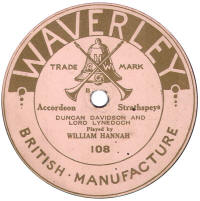 |
Wendy
(sold
in Australia) |
Another British
product for the Australian market, Wendy records were 5½" records
produced by Vocalion from their "Little Marvel" masters.
Thanks to Adam Miller
for providing the label scan. |
_small.jpg) |
|
Western Stores |
My thanks to Dr. Rainer Lotz for drawing my attention to this label,
found on Ebay.
I decided to include it
here, based on the English text, as I cannot interpret the script at the
top, which is presumably the label name.
The label says it was
made in Great Britain, but I have no idea by whom, or the approximate
date of the record. |
_small.jpg) |
|
Westport |
Curry's, the famous
Cycle makers, were masters at selling off old stock of other record
companies. Westport was a paste-over label over old-stock Imperial and
Winner records. The Winner paste-overs carry forward the same band
names, whether true or pseudonyms, but the Imperial ones don't seem to.
The "Catalogue" number ranges appear to be various and do not match the
original records under the labels. |
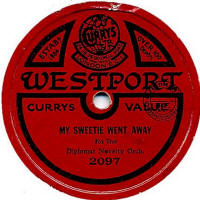 |
|
W.G.C. |
I know nothing about the Western Gramophone Company, who pasted over
stickers onto this Coliseum Record. They were presumably a shop or
factor, based at the addresses in London shown on the label. As can be
seen, the label states is was made in Prussia, and there's been no
attempt to hide this, so it must be assumed that the WGC stickered
records were sold prior to the outbreak of WWI in August 1914.
(Or, but most unlikely, post-WWI.)
I've never seen any others like
this, but I notice that the sticker incorporates some of the Coliseum
label's design, which leads me to assume there were a number of these
records and all will be old-stock Coliseum records. |
 |
|
Whitehall |
These records date
from about 1911-12. They were sold by Largs & Sons of 18-24 Whitehall
Street, Dundee and used masters from Beka. The catalogue numbers were in
an L-1 series.
Thanks to Bill Dean-Myatt for the information and label scan. |
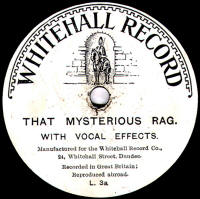 |
|
Whiteheads |
We're back in
"Paste-over" country here. Whiteheads were a well-known department store
in Bolton and their label was pasted over Duophone unbreakable records
from the late 1920s. The details and catalogue numbers matched the
original Duophones. Whiteheads survived the label by many years, and
only closed in 2006 after trading for 141 years.
|
 |
|
Whiteley |
Whiteley's were a department store in London (Queen's Road,
Bayswater). In about 1912, they started stocking their own records,
which were oversized (10½") and pressed from Grammavox masters. There
were about 150 pairs of titles in a catalogue series running from W-1. |
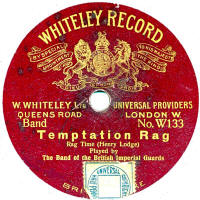 |
|
Whytsdale
|
There
were two distinctly different series of Whytsdale record, but both were
manufactured for Whyte, Risdale & Co of Bishopgate, London. The first
one shown dates from late 1908 and was
manufactured by the Disc Record Company using masters from the defunct Nicole record
company, but were pressed in normal shellac. The second style is
probably a couple of years later and was made by Edison Bell (J.E. Hough
Ltd) using their own Bell Disc masters.
Thanks to Norman Field for the first label image
and Paul Baker for the second. |
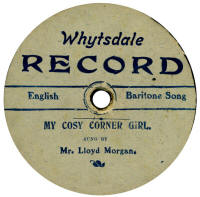
 |
|
Winner
|
Launched in 1912,
Winner was produced by J. E. Hough (The Edison Bell Co) and was a
standard-sized 10" record. Many of the company's previously issued
"Bell" master were used to start with. "Winner", being British
manufactured, was a reaction to the cheap German imports which flooded
the market just before WWI. The quality was very good, except
occasionally during the war, when cheaper material and poor pressings
dogged the label. At the demise of Hough's company in 1933, the label
was taken on by Decca and survived until late 1934.
Label listing:
Arthur Badrock &
Karlo Adrian produced a comprehensive Winner listing some years ago; the
CLPGS have copies still in stock. |
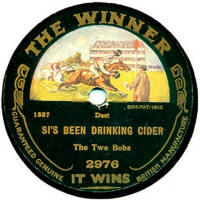 |
|
Witton |
Witton records date from 1928 when 6
records were issued; they were pressed by Edison Bell and were a 12"
disc, costing 5/- each. Unsurprisingly, given the price, they are hard
to find, and it is assumed they were made for Witton & Co, who sold gramophones & Pianos under this
name.
All 7 known records are by the same singer. The sole issue in
the W-5000 series has the same label design but with black printing
rather than green.
My thanks to
Bill Dean-Myatt for
providing the label image.
|
_small.JPG) |
|
Women's League Of Health And Beauty |
This was a series of 6 records
produced in 1934 which came provided with excercise charts.
According to the label, they were produced in cooperation with the
Linguaphone Insitute and therefore is it liklely they were manufactured
by Vocalion or Crystalate.
Thanks to Chris MacDonald for
providing the label image. |
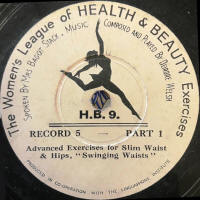 |
|
Woolworths |
My thanks to
Bill Dean-Myatt for
providing the label image.
|
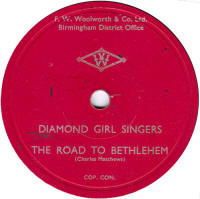 |
|
World
|
"World" was eccentric inventor Noel Pemberton-Billing's attempt to
improve recording quality and extend the playing time of records
generally. On a normal record, the actual velocity that the needle is
travelling along the groove has reduced considerably, and the sound
quality reduces likewise, towards the end of the side. By making a record where this doesn't happen
(where the rotational speed of the disc increases gradually), he not
only removed this problem, but also increased the playing time of the
record, but starting slowly and speeding up to 80rpm by the end. The problems were many: No top-line artists; the records were
expensive; you needed a special gadget to play them at the right speed
(and most gramophones weren't capable of coping with the gadget!).
They only survived for a few years in the early-to-mid 1920s. They are rare
anywhere, but copies turn up in Australia, suggesting they were sold in
both countries, or that old UK stocks were shipped out. |
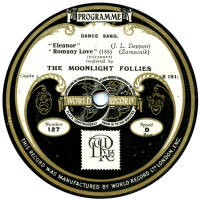 |
|
Worldecho
|
Worldecho
was originally a
record of the "unbreakable" type, like Duophones, bring made of a
central core of card, with a layer of a plastic-type material on top, for
the playing surface. The records cost 1/3 and were available during
1929-1930. They suffer from the same problem of break-up and
disintegration as Duophones and are probably quite a bit rarer. The
catalogue was in an A-1000 series and ran to about A-1042.
Then a new
B-1000 series was introduced at 2/-, made of standard shellac and with a
label that resembled America's "Van Dyke". This series was even
shorter-lived, running for about 20 issues. |
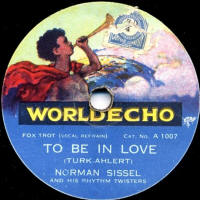 |
|
World Jewish Congress |
Thanks to Bill Dean-Myatt for the label image. |
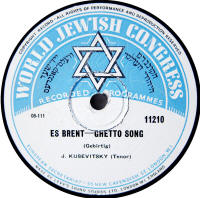 |
|
Ye Popular |
See under "Popular". |
|
|
York |
Thanks to Bill Dean-Myatt for the label image. |
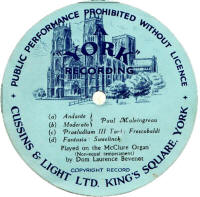 |
|
Zion |
This has an unknown source, but looks like a 1920s product.
Thanks to Bill Dean-Myatt for the label image.
|
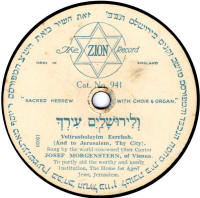
|
Zonophone
(More label designs) |
Originally an
American company, the Zonophone name was bought by the Gramophone
Company in 1903 and they started issuing single-sided 5½", 7", 10" and
12" discs. In 1913, the name was applied to the double-sided
records which had been called "Twin" and both names appeared on the
label for some years. In 1932, when Columbia & the Gramophone Company
were merged to form EMI, Zonophone was once again paired with an existing
label and Regal-Zonophone was born. This survived until 1948. The name
was revived in the 1960s (by EMI).
Label listing: the
CLPGS have
produced a full listing of the Twin & Zonophone label. |
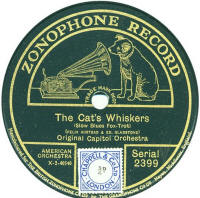 |


_small.jpg)
_small.jpg)











